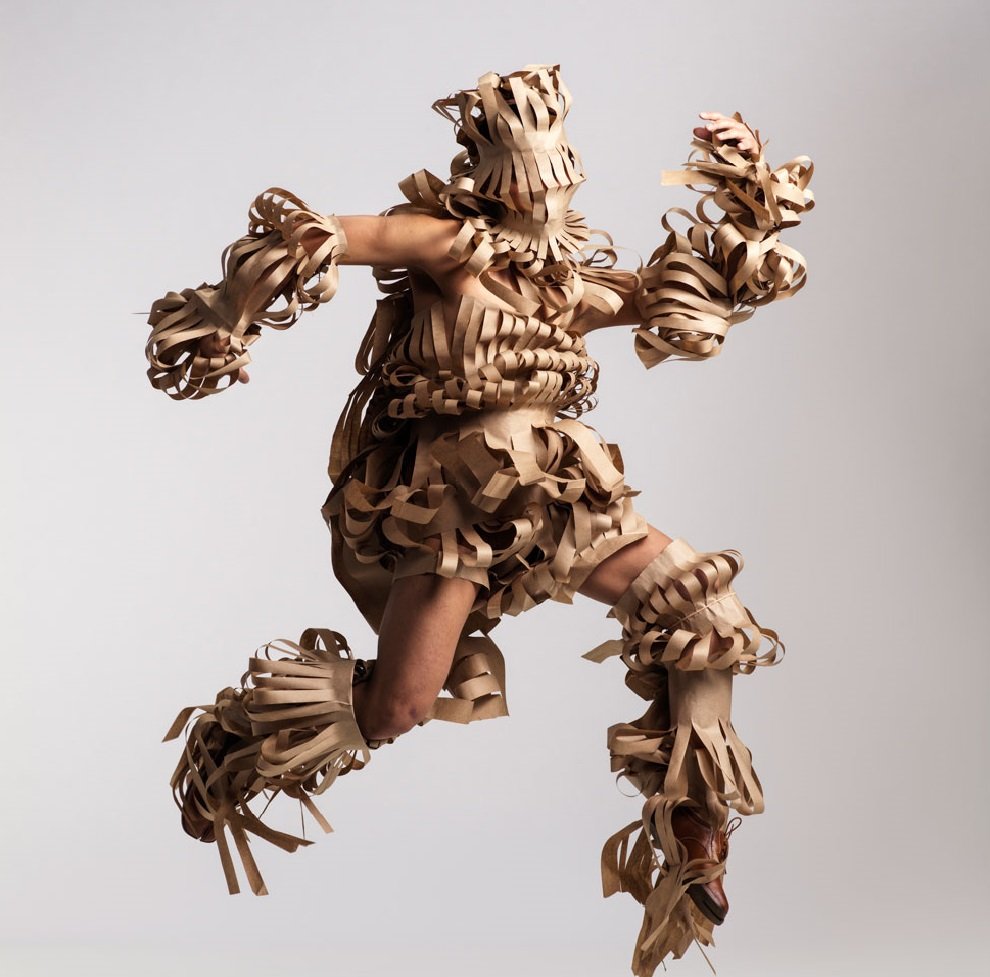Dancer Ralph Escamillan dons a dress made of packing paper in Croquis
The local artist is appearing at Dance in Vancouver with his latest piece, which requires a new garment to be made for every performance

FakeKnot, Croquis. Photo by David Cooper
The Dance Centre presents a double bill with FakeKnot’s Croquis and Ziyian Kwan/Odd Meridian Arts’ Tendrils at Dance In Vancouver on November 21 at 8 pm at the Scotiabank Dance Centre
IN PERFORMANCE ARTIST Ralph Escamillan’s recent works, costumes have taken on a life of their own. Consider PIÑA, in which dancers wore what looked like oversize butterfly wings made out of the work’s namesake fabric, which is the national textile of the Philippines and is constructed from the leaves of pineapple plants. In HINKYPUNK, the founder of FakeKnot sported a glittery bodysuit that covered his entire face. In whip, he and Daria Mikhaylyuk wore elongated leather head coverings that rendered them unable to see for the work’s entire 60 minutes. Now, in the solo Croquis, Escamillan wears a ballgown made entirely out of packing paper.
As with those aforementioned pieces, Croquis employs the costume as a tangible object that lends thematic structure and narrative. The dress has to be made from scratch anew before every single show, a process that takes hours, and becomes ruined through the act of dancing in it.
“I was really interested in how to transform this minimalist material into something really beautiful,” Escamillan says in a phone interview with Stir in advance of FakeKnot’s Dance in Vancouver appearance on November 21. “There’s the idea of temporality because it’s so fragile, and at the same time there’s chaos in creating and destructing the beauty in all this work. We do this already in dance: we spend hours and months on choreography, then it just dissipates. I was interested in how this garment of clothing was a physicalized version of that. It’s eight hours of work being destroyed in a matter of minutes.
“There’s no glue, no tape, and no staples,” he adds. “It’s held together through the mechanisms of pleating and making our own paper thread to sew through the whole garment. It’s very meditative. It’s really simple, but in a lot of ways it’s also very complex.”

FakeKnot, Croquis. Photo by David Cooper
Croquis (pronounced crow-key) takes its name from a French word meaning a quick sketch of a fashion figure, which is often the first step toward bringing an idea into reality. Escamillan explains that there’s abundant symbolism in the ballgown itself; it evokes celebration, femininity, and pomp, as well confinement and mourning, and more.
“In the early stages of the work I was playing with idea of what the skirt meant historically, and how it protected people’s literal wombs and acted as a shield of some sort,” Escamillan says. “There’s also this powerful image now as we see it brought into the queer vernacular of clothing; it’s a symbol of antagonizing gender norms as well.”
There are other reasons Escamillan was attracted to packing paper for his latest endeavour; it’s affordable—unlike piña textiles, which are very expensive—and its colour blends with the Canadian-Filipinx artist’s skin tone. “There’s a familiarity with it, and when audiences think of this material in another way, it tickles them,” he says. “People reconstruct what we think things can be.”
Escamillan, who’s the founder of Van Vogue Jam, says the ballroom culture has a profound influence on him when it comes to creating dance works and how he thinks of himself in relation to space.
“The whole idea of ballroom is manufacturing this illusion, this fantasy, and in this piece I channel a lot of the slowness—there’s a category of ballroom called face, it’s very slow, it’s not like voguing but it’s about presence and about taking in every moment,” he says. “I really love that because it allows for the viewer to take in the whole image.” ![]()
Gail Johnson is cofounder and associate editor of Stir. She is a Vancouver-based journalist who has earned local and national nominations and awards for her work. She is a certified Gladue Report writer via Indigenous Perspectives Society in partnership with Royal Roads University and is a member of a judging panel for top Vancouver restaurants.
Related Articles
Dutch accordionist Erica Roozendaal explores themes of abuse and childhood instability in her heartfelt solo performance
Performance stars creator Rick Maddocks alongside flamenco dancer Maria Avila, soprano vocalist Dory Hayley, and talented musicians
Astrolabe Musik Theatre presents Farshid Samandari’s The Greater Sea and Gheorghi Arnaoudov’s Notes of the Phantom Woman
Fuelled by curiosity and spontaneity, the acclaimed performer looks beyond the Chopin repertoire that made his name
A guest of the Vancouver Chopin Society, the veteran musician risked it all to stand up against tyranny
Alt-rock band Meltt, D.O.A. frontman Joe Keithley, and singer-songwriter Ché Aimee Dorval are among the Burrard Stage highlights
Stellar local musicians play seminal, sassy funk in North Shore Jazz presentation as part of Vancouver International Jazz Festival
In renowned one-man show I Wish I Was a Mountain, the award-winning British poet leans on rhythm of deep musical influences
Wurlitzer organ, Azerbaijani folk music, rousing chorales, and more culminate in a Vancouver Symphony Orchestra performance at the Orpheum
Newest production to feature Sound the Alarm’s lineup of seasoned singers mines soundtracks of Disney and Hollywood classics
Three concerts at RockRidge Canyon resort in Princeton highlight chamber works prepared by the artists during a week-long intensive
In Western Gold Theatre’s spare staging of Caryl Churchill’s taut, wry work, roles rotate across performances with some astonishing results
The violinist’s Fantasy Vignettes interweaves Baroque music, costume changes, and sewing machines
All-Canadian program Legacy celebrates spring and rebirth as Cassie Luftspring prepares to take the baton
The Zawose Queens, The Milk Cartons Kids, and more to hit the Main Stage at ʔəy̓alməxʷ Jericho Beach Park
Program also features North American premiere of Danish composer Thomas Agerfeldt Olesen’s Violin Concerto with violinist Simone Lamsma
Season-closing concert features guest artist Christopher Gaze and a world premiere by composer Thuthuka Sibisi
Now based in the U.S., artist brings more than 60 years of performance experience and award wins to the stage
Beatles songs and Broadway hits are on the program featuring performers of all ages
In the latest installment of the VSO at the Annex series, the conductor and pianist hopes the eclectic program will take some of the intimidation factor out of new music
Paris-born, Montreal-raised pianist won the 2021 International Chopin Piano Competition in Warsaw
At Vancouver New Music, Cheldon Paterson’s uncategorizable music fuses his love for nature with his taste for obscure sound
Compelling young artist has performed worldwide and won prizes at the National Chopin Piano Competition
Genre-spanning international and local talents take to North Shore venues in BlueShore at CapU and Vancouver International Jazz Festival presentation
Program includes an Emily Carr–inspired piece by Tawnie Olson, a composition about a satellite falling out of orbit by Chris Sivak, and more
In Have You Heard Judi Singh?, Vancouver director interweaves archival footage, re-created moments, and mesmerizing music in tribute to late Punjabi-Black artist
Set in the aftermath of World War II, updated production adds depth and nuance to the iconic work
Another 30 concerts will take place at Performance Works, Ocean Artworks, and the Revue Stage from June 20 to July 1
Tanzania’s Zawose Queens and Congo’s Les Mamans du Congo x Rrobin rub shoulders with Canadian names like Elisapie and Ocie Elliott at ʔəy̓alməxʷ Jericho Beach Park, July 18 to 20
At Pacific Spirit United Church, program draws on previously performed works by Bach, Mahler, and more
































